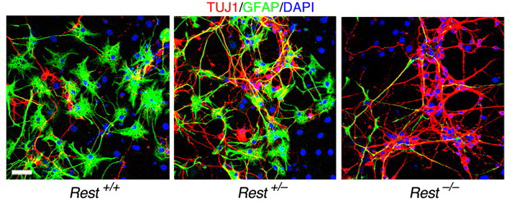A stem cell needs REST
Posted by Erin M Campbell, on 14 August 2012
Decisions, decisions. Stem cells face the task to self-renew or differentiate, a decision made out of the combination and coordination of numerous regulators. With the activation or suppression of transcriptional activators and the activation or suppression of repressors, it’s easy to see how understanding this process is anything BUT easy. Today’s images are from a Development paper that describes the importance REST in neural stem/progenitor self-renewal and differentiation.
Neural development begins with neural stem cells and progenitor cells, and follows a specific time-line of differentiation involving neurons and glial cells. The orderly progression through cell fates requires a complex network of regulators, but the specifics are unclear. A recent paper in Development describes the importance of REST, a transcriptional repressor of neuronal genes, in the development of the nervous system. REST, along with its co-repressor CoREST, suppresses neural fates in cells outside of the nervous system. In this paper, Covey and colleagues found that REST maintains neural stem/progenitor (NS/P) cell self-renewal, and limits maturation into neural and glial cell fates. In addition, a high level of REST in embryonic stem (ES) cells is important in suppressing transcription of neuronal genes, but is not required for ES pluripotency. NS/P cells lacking REST have reduced self-renewal capacity and precocious neuronal differentiation. As seen in the images above, REST heterozygote (middle) and homozygote knockout (right) ES cell-derived neurospheres have increased numbers of neurons (red, TUJ1) compared with control neurospheres (left). REST null neurospheres also produced fewer astrocytes (green, GFAP).
For a more general description of this image, see my imaging blog within EuroStemCell, the European stem cell portal.
![]() Covey MV, Streb JW, Spektor R, & Ballas N (2012). REST regulates the pool size of the different neural lineages by restricting the generation of neurons and oligodendrocytes from neural stem/progenitor cells. Development (Cambridge, England), 139 (16), 2878-90 PMID: 22791895
Covey MV, Streb JW, Spektor R, & Ballas N (2012). REST regulates the pool size of the different neural lineages by restricting the generation of neurons and oligodendrocytes from neural stem/progenitor cells. Development (Cambridge, England), 139 (16), 2878-90 PMID: 22791895



 (2 votes)
(2 votes)